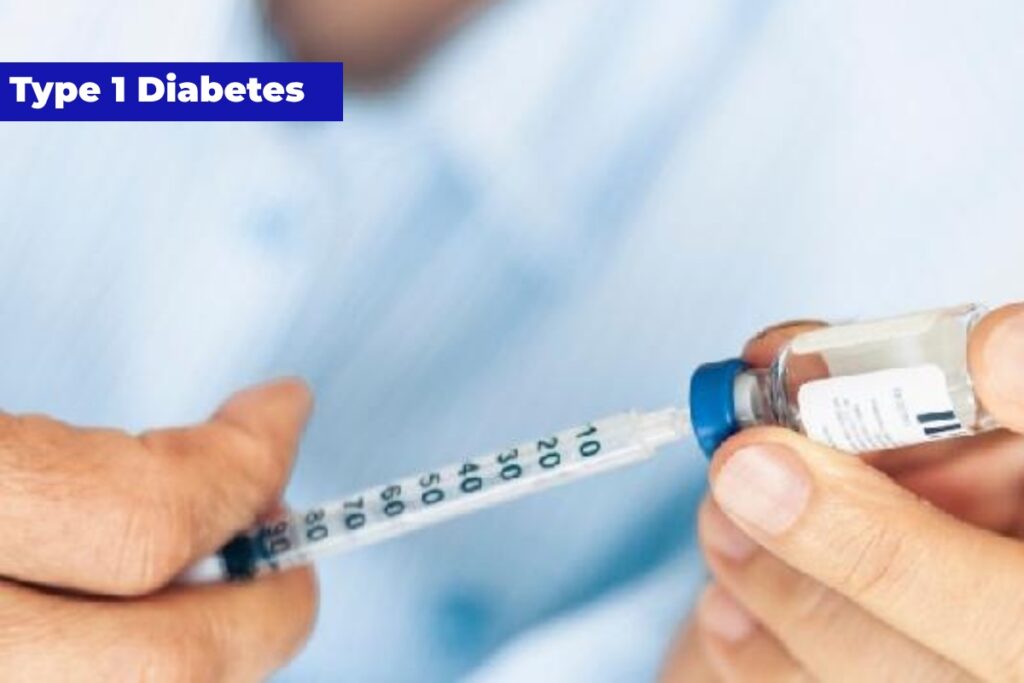
Type 1 diabetes
Type 1 Diabetes
Type 1 Diabetes is a type of diabetes that typically develops in childhood or adolescence.
This type occurs when the immune system mistakenly attacks and destroys insulin-producing cells in the pancreas.
In type 1 diabetes, the pancreas produces little to no insulin. Treatment involves daily insulin injections or an insulin pump for survival.
Unfortunately, type 1 diabetes is not preventable and is believed to involve a combination of genetic and environmental factors.
What is Type 1 Diabetes?
Type 1 diabetes is a chronic medical condition characterized by the immune system mistakenly attacking and destroying insulin-producing beta cells in the pancreas.
Insulin is a hormone crucial for regulating blood sugar (glucose) levels.
Without sufficient insulin, the body cannot effectively process glucose, leading to elevated blood sugar levels.
Generally, diabetes is a health issue that arises when the amount of glucose, or sugar, in your blood becomes too high.
Glucose acts like the fuel that gives your body energy, mainly coming from the food you eat.
Insulin, a special helper hormone produced by your pancreas, is like the key that allows glucose into your cells for energy.
Another helper hormone, called glucagon, also collaborates with insulin to maintain proper blood sugar levels.
However, in type 1 diabetes, the immune system, which usually fights off germs, becomes confused and attacks the insulin-producing cells in your pancreas.
As a result, the pancreas cannot produce enough insulin or none at all.
Without sufficient insulin, glucose cannot enter the cells, causing the blood sugar levels to rise higher than expected.
This is why people with type 1 diabetes need to take insulin every day to stay healthy.
The exact cause of type 1 diabetes is not fully understood, but it is believed to involve a combination of genetic and environmental factors.
Symptoms of Type 1 Diabetes
The onset of symptoms in Type 1 diabetes is usually mild initially and tends to worsen or become more severe over time.
It may take several months or even years before the symptoms of type 1 diabetes become noticeable.
However, in some cases, symptoms can develop within a few weeks or months. Once symptoms manifest, they can be quite severe.
This progression occurs because the pancreas gradually produces less insulin, leading to imbalances in blood sugar levels.
Common Symptoms
Type 1 diabetes can manifest abruptly, with symptoms that vary among individuals.
These symptoms encompass a range of signs indicating the presence of the condition. Some common ones include:
- Excessive hunger: Individuals with Type 1 diabetes may experience persistent feelings of hunger, even after consuming a meal.
- Excessive thirst: Increased thirst, known as polydipsia, is a common symptom of type 1 diabetes. It occurs as a result of the body’s attempts to flush out excess sugar through increased urine production.
- Frequent urination: People with Type 1 diabetes often have to urinate more frequently than usual. This can be particularly noticeable in infants, who may have full diapers more frequently, and in children, who may experience bedwetting.
- Blurred vision: Blurriness or changes in vision can occur as a result of high blood sugar levels affecting the fluid balance in the eyes.
- Unexplained weight loss: Rapid and unexplained weight loss can be a sign of type 1 diabetes. It happens because the body is unable to properly utilize glucose for energy, leading to the breakdown of fat and muscle tissues.
- Fatigue: Feeling excessively tired or fatigued, even after getting adequate rest, can be a symptom of type 1 diabetes. The body’s inability to effectively convert glucose into energy can contribute to persistent fatigue.
- Slow healing of cuts and sores: Individuals with Type 1 diabetes may experience delays in wound healing. High blood sugar levels can impair the body’s ability to heal cuts and sores efficiently.
- Vaginal yeast infections: In women, recurring vaginal yeast infections may be a symptom of type 1 diabetes. Elevated blood sugar levels create an environment favorable for yeast overgrowth.
- Mood changes and irritability: Fluctuations in blood sugar levels can affect mood and lead to irritability or other changes in emotional well-being.
Note
It is important to note that some symptoms of type 1 diabetes may resemble those of other health conditions.
Also note that experiencing one or more of these symptoms does not necessarily indicate the presence of type 1 diabetes.
However, if you are experiencing these symptoms or are concerned about your health, it is advisable to consult a healthcare professional for an accurate diagnosis and appropriate medical guidance.
Your doctor, for instance, can conduct a blood sugar test to determine the proper diagnosis.
It is crucial not to leave diabetes untreated, as it can result in severe or even life-threatening health complications.
Risk Factors for Type 1 Diabetes
Several factors contribute to the risk of developing Type 1 diabetes.
Understanding these risk factors can help identify individuals who may be more susceptible to the condition.
The following are some key factors that can increase the risk of type 1 diabetes:
History of the Family
Having a close relative, such as a parent or sibling, with Type 1 diabetes slightly elevates the risk of developing the condition.
Although the exact reasons are not fully understood, genetic factors likely play a role in this increased risk.
Genetics Factors
Certain genetic markers or variations can increase the susceptibility to type 1 diabetes.
These genetic factors can influence the immune system’s response and the risk of developing autoimmune disorders like type 1 diabetes.
However, it is important to note that having these genetic markers does not guarantee the development of the condition.
Geographical Region
The prevalence of Type 1 diabetes varies geographically.
Studies have shown that the incidence of type 1 diabetes tends to be higher in regions farther away from the equator.
The reasons for this geographical pattern are not yet fully understood, but it suggests the involvement of environmental factors, such as sunlight exposure and vitamin D levels, in combination with genetic factors.
Age
Type 1 diabetes can manifest at any age, but there are specific age-related patterns.
The condition is more commonly diagnosed at two distinct age peaks.
The first peak occurs in children between the ages of 4 and 7, while the second peak is observed in children between the ages of 10 and 14 years old.
The reasons behind these age-related patterns are still under investigation, and factors such as hormonal changes and immune system development may contribute to the timing of disease onset.
Note about Rick Factor
It is important to note that while these risk factors increase the likelihood of developing Type 1 diabetes, they do not provide a definitive prediction.
Many individuals with Type 1 diabetes have no known risk factors, and not everyone with these risk factors will develop the condition.
Therefore, it is essential to maintain regular health check-ups and consult with healthcare professionals if you have concerns about your risk or experience any symptoms associated with type 1 diabetes.
Type 1 Diabetes Diagnostic Journey
Diagnosing type 1 diabetes involves a series of tests to assess blood sugar levels, identify the presence of autoantibodies attacking healthy tissues, and rule out any serious complications.
Here’s a breakdown of the typical diagnostic steps:
Blood Sugar Tests
To assess the sugar levels in your blood, your healthcare provider will employ a blood glucose test. They may request two types of tests: a random test and a fasting test.
- Random Blood Glucose Test: This quick test is conducted without fasting. It provides a snapshot of your blood sugar level at a specific moment. While not definitive, a very high random blood sugar reading can raise suspicion of diabetes.
- Fasting Blood Glucose Test: This test measures your blood sugar after not eating or drinking anything (except water) for at least 8 hours. Specific blood sugar levels above a certain threshold after fasting are indicative of diabetes.
Glycosylated Hemoglobin (A1c) Test
This blood test offers a broader picture of your blood sugar control over a longer period, typically the preceding 2–3 months.
An A1c level exceeding a specific cut-off point further strengthens the possibility of diabetes.
Antibody Test
This test identifies the presence of autoantibodies, proteins mistakenly produced by your immune system that attack healthy insulin-producing cells in the pancreas.
The detection of specific autoantibodies is a strong indicator of type 1 diabetes, as these are typically not present in type 2 diabetes.
Additional Tests for Overall Health and Potential Complications
- Basic Metabolic Panel (BMP): This comprehensive blood test measures various substances in your blood, providing insights into your overall metabolic health and electrolyte balance.
- Urinalysis: This test analyzes your urine for various components, including ketones. Ketones are produced by the body when it breaks down fat for energy instead of using glucose due to a lack of insulin. The presence of ketones in the urine can be a sign of diabetic ketoacidosis (DKA), a serious complication of undiagnosed or untreated type 1 diabetes.
- Arterial Blood Gas (ABG) Test: In some cases, your doctor may order an ABG test, which measures the levels of oxygen and carbon dioxide in your blood drawn from an artery. This test might be used if DKA is suspected.
Putting the Pieces Together
The results from these tests are combined with a patient’s medical history and any symptoms you may be experiencing to arrive at a diagnosis.
In most cases, a combination of a high blood sugar level, the presence of autoantibodies, and potentially the presence of ketones in the urine will point towards type 1 diabetes.
It’s important to note that not every test result will be abnormal in every case.
The doctor will interpret the results in the context of the patient’s individual situation and may recommend additional tests if needed to confirm the diagnosis.
Early diagnosis and prompt treatment are crucial for managing type 1 diabetes effectively and preventing complications.
How is Type 1 Diabetes Treated?
While there’s no cure yet for type 1 diabetes, effective management strategies exist to help you live a full and healthy life.
Doctors create personalized diabetes care plans to address your specific needs and goals.
These plans typically encompass four key pillars:
- Insulin Therapy: Since your body doesn’t produce enough insulin, you’ll need to take it externally. Insulin can be administered through injections or via an insulin pump, a small device that delivers insulin continuously throughout the day. Many types of insulin are available, and your doctor will help you determine the most suitable option for you.
- Healthy Eating and Carbohydrate Counting: Maintaining a balanced diet with a focus on whole foods is crucial. Learning to count carbohydrates in your meals helps you anticipate how they will affect your blood sugar levels and allows for proper insulin dosing.
- Blood Sugar Monitoring: Regularly checking your blood sugar levels (usually four times a day or more) is essential for understanding your body’s response to food, exercise, and insulin. This information empowers you to make informed decisions about your diabetes management.
- Physical Activity: Regular exercise plays a vital role in maintaining healthy blood sugar levels and overall well-being. Your doctor can help you develop a safe and effective exercise routine.
Technological Advancements in Treatment
The field of diabetes management is constantly evolving. Exciting advancements include:
- Continuous Glucose Monitoring (CGM): These devices provide real-time blood sugar readings, offering valuable insights into glucose fluctuations throughout the day.
- Insulin Pumps: Advanced pumps can be integrated with CGMs to create a closed-loop system that automatically adjusts insulin delivery based on your real-time blood sugar levels. This technology can significantly improve blood sugar control.
Pancreas Transplants: A Potential Option
In some cases, a pancreas transplant may be considered. A successful transplant can eliminate the need for external insulin injections.
However, this is a major surgery with associated risks and requires lifelong immunosuppressive medications to prevent rejection of the transplanted organ.
Pancreas transplants are typically reserved for individuals with severe complications from type 1 diabetes.
Working with Your Healthcare Team
The journey with type 1 diabetes is best navigated with the support of a qualified healthcare team.
Your doctor will guide you in creating a personalized treatment plan, selecting the most appropriate insulin regimen, and incorporating technological advancements as needed.
Open communication and ongoing collaboration are key to achieving optimal blood sugar control and living a healthy life with type 1 diabetes.
Type 1 Diabetes Complications
While Type 1 diabetes is a manageable condition, chronically high blood sugar levels can lead to serious health complications over time.
Early diagnosis, consistent blood sugar monitoring, and proper management are crucial to minimizing these risks.
Let’s explore some of the key complications associated with type 1 diabetes:
Cardiovascular Disease (Heart and Blood Vessel Damage)
Diabetes significantly increases the risk of heart and blood vessel problems.
This includes coronary artery disease (leading to chest pain), heart attack, stroke, narrowed arteries (atherosclerosis), and high blood pressure.
These conditions often stem from a combination of factors like high blood sugar, high blood pressure, and high cholesterol, all of which are more prevalent in people with diabetes.
Neuropathy (Nerve Damage)
Chronically high blood sugar can damage the tiny blood vessels that nourish nerves, especially those in the legs.
This nerve damage, called neuropathy, can cause a range of symptoms, including tingling, numbness, burning pain, and eventually a complete loss of feeling in the affected limbs.
Digestive problems like nausea, vomiting, diarrhea, or constipation can also arise due to nerve damage impacting the digestive system.
Additionally, men who have diabetes may also encounter erectile dysfunction.
Nephropathy (Kidney Damage)
The filtration of waste products from the bloodstream is a task carried out by the kidneys.
Diabetes can damage the delicate filtering system within the kidneys, leading to a condition called nephropathy.
Approximately 20% to 30% of individuals diagnosed with type 1 diabetes develop a condition known as nephropathy.
The likelihood of developing nephropathy increases with the passage of time, and it typically manifests between 15 and 25 years after the onset of diabetes.
In severe cases, this can progress to kidney failure, requiring dialysis or a kidney transplant for proper function.
Retinopathy (Disease of the Retina)
Diabetes can damage the blood vessels in the retina, the light-sensitive part of the eye.
If left untreated, diabetic retinopathy, a condition characterized by damage to the retina, can result in vision loss and blindness.
Additionally, diabetes increases the risk of cataracts and glaucoma, further compromising vision.
In approximately 80% of adults who have been living with type 1 diabetes for more than 15 years, this eye problem occurs.
However, regardless of the duration of the disease, it is uncommon before reaching puberty.
Foot Injury Complications
High blood sugar levels can gradually damage the nerves and blood vessels in the feet of people with diabetes.
This condition, called diabetic neuropathy, can cause numbness, tingling, pain, or a reduced sense of feeling in the feet.
The combination of nerve damage and poor blood flow to the feet creates a significant risk for infection.
People with diabetes may not feel minor cuts, blisters, or even injuries like fractures due to neuropathy.
Additionally, reduced blood flow hinders healing, making even small injuries potentially serious.
Untreated infections can progress to tissue death (gangrene) and potentially require amputation of toes, feet, or even legs.
Skin and Mouth Complications
People with type 1 diabetes are more susceptible to developing infections of the skin and mouth.
These infections can be bacterial or fungal in nature. Diabetes can also contribute to skin problems like blisters or rashes.
Other Complications
People with diabetes are also more prone to skin and mouth infections, gum disease, and dry mouth.
Additionally, for pregnant women with Type 1 diabetes, high blood sugar levels can pose a threat to both mother and baby, increasing the risk of miscarriage, stillbirth, and birth defects.
Note
Maintaining healthy blood sugar levels through proper diet, exercise, and medication is the cornerstone of preventing or delaying these complications.
Regular checkups and screenings with your healthcare team are essential for the early detection and treatment of any potential issues.
By managing your diabetes effectively, you can significantly reduce your risk of complications and live a long, healthy life.
Final Note
Type 1 diabetes is characterized by the pancreas’s inability to produce insulin. Insulin is essential for facilitating the entry of glucose into cells.
In the absence of insulin, glucose remains in the bloodstream, resulting in elevated blood sugar levels.
Prolonged high blood sugar levels can have detrimental effects on health and give rise to various complications.
If you or your child are experiencing symptoms of type 1 diabetes, such as excessive thirst and frequent urination, it’s crucial to seek medical attention from your healthcare provider as soon as possible.
Early diagnosis and intervention are essential for effective management of the condition and preventing complications.
Receiving a type 1 diabetes diagnosis can be life-changing. However, it’s important to remember that this doesn’t have to limit your ability to live a full and healthy life. Type 1 diabetes requires constant care and management on a daily basis.
While it may feel overwhelming at first, you’ll gradually gain a better understanding of how to manage the condition and how to stay in tune with your body’s signals.
Regular visits to your endocrinologist and other healthcare providers are vital for ongoing monitoring and managing your type 1 diabetes.
Remember, you’re not alone in this journey. Building a strong support system is key.
This includes your medical team, friends, and family. Don’t hesitate to reach out to them for help, encouragement, and guidance whenever you need it.
Together, you can navigate the path of managing type 1 diabetes effectively and live a fulfilling life.
Sharing valuable content is a great way to help others! If you found this post about “Type 1 Diabetes” helpful or think it might be useful to others, please feel free to share it. You never know who might need this information. Thank you!







